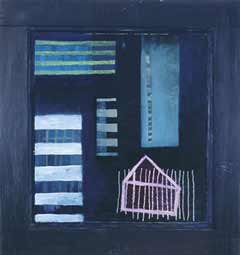 |
|||||||||||||
|
|||||||||||||
 |
||
| Fresh Paint Eight artists, each with a distinctive sensibility, sources of inspiration, and style - what do they have in common? Nothing less than fresh, at times astounding ways of using paint to achieve their individual ends. Brought together by MacLean Fine Art in Fresh Paint 2, their new work provides a marvellously rich and varied spectrum of visual experience. In doing so, it bears witness to the continuing vitality of paint, whether as a medium of enquiry, expression or revelation. Scottish painter Jennifer Anderson's figure studies are suffused with a icy, blue, unsparing light. Observed obliquely - from above, or in profile - and isolated against featureless backgrounds, Anderson's subjects seem to balance their own reserve, their self-sufficient presence, against the artist's sustained scrutiny. Surfaces - a creased white shirt, scraped-back jet-black hair, or the slope of a cheek-bone - are described fluently, the restrained palette emphasising subtle tonal shifts. These haunting images explore the limits of what we can learn from observation - even observation of those whom we see often and know well - something which gives Anderson's work a universal quality transcending most individual portraiture. Intense, saturated colour infuses Scottish artist Simon Laurie's compositions. Everyday items, the staples of still-life arrangements - cups, plates, beakers - are transformed into simple, flat, almost hieroglyphic forms, and then deployed against a richly nuanced, brilliantly-coloured ground. Although painted in acrylics on board, the compositions often recall collage. With their jewel-like clarity, satisfying rhythms, and intimations of a distilled and purified reality, these works present a distinctive vision of the world that surrounds us, while Laurie's evident interest in pattern-making ensures that these images continue to delight, as well as describe. Louis Sinclair McNally creates landscapes which, despite the considerable naturalistic force underpinning them, are by no means literal (and hence neutral) reports from the world around him. Rather, once he has experienced, for whatever reason, a moment of real connection with a particular place - often in his native Scotland - he then spends weeks using drawings, photos, memory and the formal imperatives of the resulting composition to fashion an image which is at once emotive and visually compelling. Intuition is heightened and articulated by intellect. These works - full of long, low horizons, severe shadows, memorable silhouettes and finely-observed atmospheric effects - evoke landscape, not as it really is, but as it scars the retina and the heart. The result is haunting, and oddly moving, too. Scottish artist Saul Robertson paints with formidable illusionistic skill. His compositions are made up of everyday objects - a suit, a shawl, a burnt-out match, a gnawed apple-core - and are satisfying in formal terms, yet are so highly charged with symbolic significance and intimations of complex narrative that it hardly seems possible to classify them as still-lifes. Robertson says that he nearly always has a specific reason for including a particular object in a composition, but is wary of disclosing too much information about this choice; the titles of the works, suggestive rather than conclusive, encourage rather than curtail speculation. Starkly lit, unsparingly rendered, the scenes are mysterious, more than slightly sinister, and always executed with studied proficiency. Donald Provan's landscapes are drawn from his native Scotland - notably East Wemyss, an old mining village where he used to fish as a boy. Employing a very limited palette - shades of graphite and sand - Provan achieves a remarkable complexity of tone and texture. Water is central here - the ceaselessly changing surface, the curve of this shoreline, its unrelenting greyness - an emphasis heightened by the unpeopled, understated nature of the compositions. Indeed, although the works all have their origin in individual experience, the compositions are so powerful, and so simple, that in places the work almost shades into abstraction, effectively bridging the gap between the specific and the universal. Donkeys, elephants, wild-eyed dairy cattle: these are English artist Duncan Wright's subject-matter. A casual first glance reveals only lyrical, rather fragile-looking oil studies, built up from many transparent oil washes. Yet almost immediately one senses something unsettling - a little eerie even - about these paintings. By placing his figures on an ambiguous, empty ground, Wright strips away from them the context (pastoral or otherwise) we might have anticipated; he plays games not only with scale, but with the images themselves. Take a closer look, and one finds that the biomorphic forms are unnervingly, if slightly, distorted - the elephants, for instance, have small target-marks on them. The real subjects here are repetition and nostalgia, bound up with slight and subtle patterns of mutation. Wright draws upon a complex network of personal experiences and associations; it is not, however, necessary to understand these fully in order to appreciate the honesty and originality of his paintings. Emotion - almost painfully raw feeling - emanates from Scottish artist Sabrina Rowan Hamilton's abstract works. The loss of a beloved house forced the artist to embark on an uncharted journey through memory and imagination. Earlier work - lyrical, brightly-coloured - was set aside in favour of fiercely gestural experimentation and a black-and-white palette, executed in oils sometimes roughened up with marble dust or sand. Evolving a personal iconography out of geometric, architectonic forms, Rowan Hamilton finds herself searching in the paint for ways in which to make memory visible, and for some inner place where freedom, and perhaps also safety, can be found. These are wild, angry, almost frightening works, yet the sense of danger that pervades them also gives them an undeniable, unforgettable force. These, then, are the eight artists whose work makes up Fresh Paint 2. Each, in his or her own way, has done something new and distinctive with paint - a medium as old as mankind, and as fresh as the best new art made from it. Bunny Smedley London 2002 |